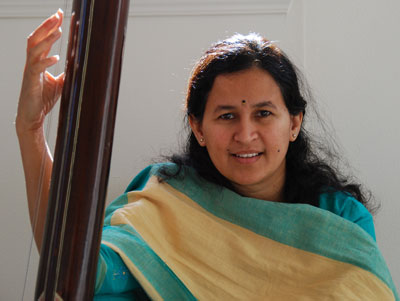Shubhangi Sakhalkar
North Indian Hindustani vocals
 North India’s Hindustani classical music is an ancient musical art form that has evolved from both folk music and Vedic (religious) chanting since the 12th century. Under the Mughal Empire in the 17th and 18th centuries, it absorbed Persian influences, which led to its current most popular form known as khayal, which means “thought.” Different gharanas (schools) emerged which were patronized by the royal courts, each representing a different style of thinking, teaching, performing, and appreciating khayal, and each creating their own lineage of singers through the guru-shisshya (master-apprentice) tradition. Today, the government has replaced the royal patronage system, which has helped bring Hindustani classical artists to the Indian public.
North India’s Hindustani classical music is an ancient musical art form that has evolved from both folk music and Vedic (religious) chanting since the 12th century. Under the Mughal Empire in the 17th and 18th centuries, it absorbed Persian influences, which led to its current most popular form known as khayal, which means “thought.” Different gharanas (schools) emerged which were patronized by the royal courts, each representing a different style of thinking, teaching, performing, and appreciating khayal, and each creating their own lineage of singers through the guru-shisshya (master-apprentice) tradition. Today, the government has replaced the royal patronage system, which has helped bring Hindustani classical artists to the Indian public.
The two main elements of Hindustani music are raag (melodic modes) and taal (rhythmic cycles). Raag literally means “color,” and each raag has its own emotional color or mood. Each raag has a specific structure and set of notes, and each taal has a specific rhythmic cycle and set number of beats. In khayal compositions, there are only four lines of lyrics; the challenge and purpose of the khayal is to convey the feeling of the raag by creating musical phrases which are aesthetically pleasing and reveal the nature of the raag.
Master vocalist Shubhangi Sakhalkar started learning Hindustani vocals at the age of 14 in Mumbai, India. After training with Kunda Vaishampayan, Dr. Prabha Atre, and Padma Talwalkare, Shubhangi went on to receive her Master’s degree in Music from Mumbai’s SNDT University, where she ranked first in her class. Having studied and performed Hindustani music for over 30 years, Shubhangi says, “It makes me a whole person, gives me peace and content and a sense of satisfaction. Hindustani classical music is very spiritual and calming. Practicing this ancient art form is like worshipping God for me.”
Shubhangi participated in ACTA’s Apprenticeship Program in 2010 with apprentice Seema Gupta. The apprenticeship emphasized Seema’s immersion into nuances, interpretation, and improvisation of various raags. Shubhangi focused on polishing Seema’s vocal skills and technique, and encourage Seema’s formulation of her own style and personal interpretation within the tradition.


